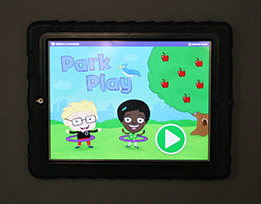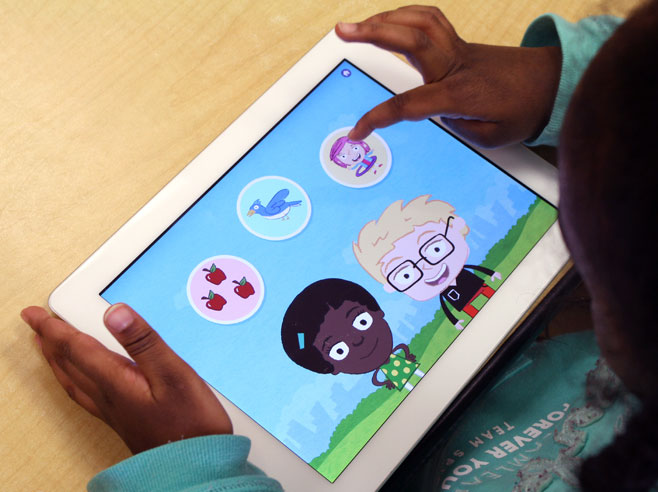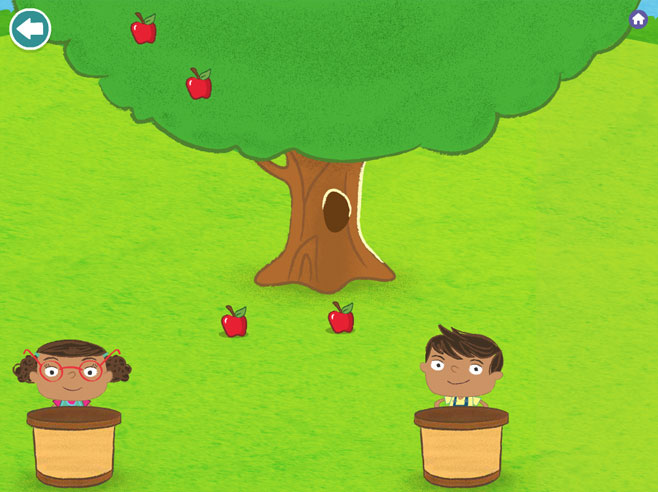There is so much to share at the park! Children share apples and hula hoops among friends and divide up pies for birds.
Materials

- Park Play digital game on the iPad
Preparation
- Make sure the iPads are adequately charged and Park Play is installed.
Directions
- Start with one iPad (keep any additional iPads out of reach).
- Introduce the game. Tell the children they are going to play a game called Park Play on the iPad(s). Tell them that everyone will get a chance to play. Explain that the object of the game is to share different types of objects equally.
- Demonstrate how to play the game. The game has areas that children can play in: apples in trees, birds with pies, and Gracie and her friends with hula hoops. Each area starts with a brief training level. An animated tutorial show the children how to shake the apples out of the tree and drag them to the baskets, cut up pieces of pie and drag them to the plates, and drag the hula hoops to a group of friends. Show children these animations and have them follow the instructions provided for each area of the game. You can switch between the area by tapping the back arrow in the top-left corner of the screen. Tell children they can switch back -and -forth between the screens during play by using the same back arrow.
- Distribute any additional iPads and invite children to play the game. Be available throughout game play. Allow children to play on their own or with a partner while you observe and engage them in conversations about the math. Choose moments to interact that do not interrupt game play, such as at the start of a new level, or when a child is struggling and is open to assistance.
- Promote math talk and learning:
- Ask questions to gauge understanding, such as, Do all the baskets have the same number of apples? What do you have to do with the pie?
- Draw attention to the shapes in the game. For example, say, Look at the pie. It’s a circle. What does it become when you cut it? (triangles) How would you make four triangles?
- Have children count out loud as they distribute items.
- To get children to communicate verbally and logically about the math task and their thinking, ask questions such as, ask, What are you doing in this game? How do you win in this game?
- Model math talk by using words like same and equal when comparing amounts. Be sure to define new math words to ensure that children understand what they mean.
- As each area of the game advances, the levels become more difficult, with more items to share. Assist children having problems with the math, especially as equal sharing gets more difficult. Reassure children that it’s okay if the game feels hard. It will get easier as they practice. Here are some typical problems children experience and some suggested solutions:
- If children have trouble giving characters equal shares of items, have them count the number of items they’ve given to each of the characters and ask, Do they have the same? Why did you give Gracie another hula hoop? Which basket has more apples? How can you share the apples equally among the baskets?
- Children may also have difficulty identifying when two pieces of pie are equal in size. Demonstrate differences in size using various pie pieces cut out of paper. Have children place the pieces on top of each other and describe the differences. Ask children, Which one is bigger? Which one is smaller? Are they the same size?
- Assist children as needed with the mechanics of game play, but keep the main focus on math talk.
- If children have trouble cutting whole objects into pieces, demonstrate how to cut the pie. Start with your finger touching the outside of the plate and drag it across the pie to the other side of the plate. You may want to guide the child’s finger across, or talk them through it.
- Children may try to cut the pie with the side of their hand, or by holding down the pie with one finger and cutting with another, but these techniques do not work as well as using a single finger and starting the cut outside the plate.
- Children learn from and teach each other — especially when they’re playing! Encourage simultaneous or collaborative play for struggling children. Invite more advanced children to explain how they make fair shares with the different items.
- Overall, have fun and allow the children to have fun too. They’ll learn while playing!

